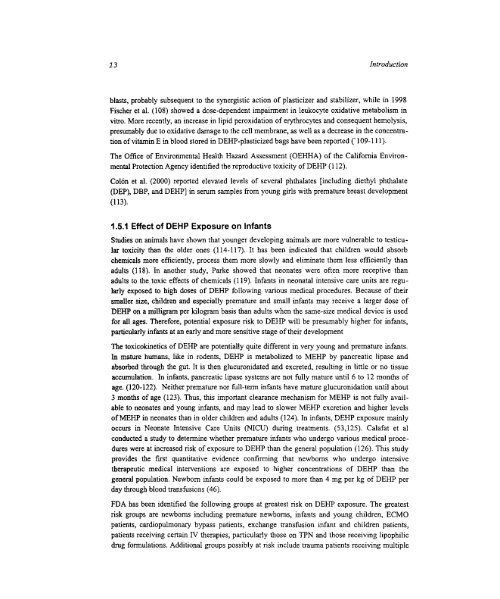Studies on Metallocene Polyolefin and Polyvinyl Chloride for Blood ...
Studies on Metallocene Polyolefin and Polyvinyl Chloride for Blood ...
Studies on Metallocene Polyolefin and Polyvinyl Chloride for Blood ...
You also want an ePaper? Increase the reach of your titles
YUMPU automatically turns print PDFs into web optimized ePapers that Google loves.
13<br />
Introducti<strong>on</strong><br />
blasts, probably subsequent to the synergistic acti<strong>on</strong> of plasticizer <strong>and</strong> stabilizer, while in 1998<br />
Fischer et al. (108) showed a dose-dependent impairment in leukocyte oxidative metabolism in<br />
vitro. More recently, an increase in lipid peroxidati<strong>on</strong> of erythrocytes <strong>and</strong> c<strong>on</strong>sequent hernolysis,<br />
presumably due to oxidative damage to the cell membrane, as well as a decrease in the c<strong>on</strong>centrati<strong>on</strong><br />
ofvitamin E in blood stored in DEHP-plasticized bags have been reported Cl09-111).<br />
The Office of Envir<strong>on</strong>mental Health Hazard Assessment (OEHHA) of the Cali<strong>for</strong>nia Envir<strong>on</strong>mental<br />
Protecti<strong>on</strong> Agency identified the reproductive toxicity ofDEHP (112).<br />
Col<strong>on</strong> et al. (2000) reported elevated levels of several phthalates [including diethyl phthalate<br />
(DEP), DBP, <strong>and</strong> DEHP] in serum samples from young girls with premature breast development<br />
(113).<br />
1.5.1 Effect of DEHP Exposure <strong>on</strong> Infants<br />
<str<strong>on</strong>g>Studies</str<strong>on</strong>g> <strong>on</strong> animals have shown that younger developing animals are more vulnerable to testicular<br />
toxicity than the older <strong>on</strong>es (114-117). It has been indicated that children would absorb<br />
chemicals more efficiently, process them more slowly <strong>and</strong> eliminate them less efficiently than<br />
adults (118). In another study, Parke showed that ne<strong>on</strong>ates were often more receptive than<br />
adults to the toxic effects of chemicals (119). Infants in ne<strong>on</strong>atal intensive care units are regularly<br />
exposed to high doses of DEHP following various medical procedures. Because of their<br />
smaller size, children <strong>and</strong> especially premature <strong>and</strong> small infants may receive a larger dose of<br />
DEHP <strong>on</strong> a milligram per kilogram basis than adults when the same-size medical device is used<br />
<strong>for</strong> all ages. There<strong>for</strong>e, potential exposure risk to DEHP will be presumably higher <strong>for</strong> infants,<br />
particularly infants at an early <strong>and</strong> more sensitive stage oftheir development<br />
The toxicokinetics of DEHP are potentially quite different in very young <strong>and</strong> premature infants.<br />
In mature humans, like in rodents, DEHP is metabolized to MEHP by pancreatic lipase <strong>and</strong><br />
absorbed through the gut. It is then glucur<strong>on</strong>idated <strong>and</strong> excreted, resulting in little or no tissue<br />
accumulati<strong>on</strong>. In infants, pancreatic lipase systems are not fully mature until 6 to 12 m<strong>on</strong>ths of<br />
age. (120-122). Neither premature nor full-term infants have mature glucur<strong>on</strong>idati<strong>on</strong> until about<br />
3 m<strong>on</strong>ths of age (123). Thus, this important clearance mechanism <strong>for</strong> MEHP is not fully available<br />
to ne<strong>on</strong>ates <strong>and</strong> young infants, <strong>and</strong> may lead to slower MEHP excreti<strong>on</strong> <strong>and</strong> higher levels<br />
ofMEHP in ne<strong>on</strong>ates than in older children <strong>and</strong> adults (124). In infants, DEHP exposure mainly<br />
occurs in Ne<strong>on</strong>ate Intensive Care Units (NICU) during treatments. (53,125). Calafat et al<br />
c<strong>on</strong>ducted a study to determine whether premature infants who undergo various medical procedures<br />
were at increased risk of exposure to DEHP than the general populati<strong>on</strong> (126). This study<br />
provides the first quantitative evidence c<strong>on</strong>firming that newborns who undergo intensive<br />
therapeutic medical interventi<strong>on</strong>s are exposed to higher c<strong>on</strong>centrati<strong>on</strong>s of DEHP than the<br />
general populati<strong>on</strong>. Newborn infants could be exposed to more than 4 mg per kg of DEHP per<br />
day through blood transfusi<strong>on</strong>s (46).<br />
FDA has been identified the following groups at greatest risk <strong>on</strong> DEHP exposure. The greatest<br />
risk groups are newboms including premature newborns, infants <strong>and</strong> young children, ECMO<br />
patients, cardiopulm<strong>on</strong>ary bypass patients, exchange transfusi<strong>on</strong> infant <strong>and</strong> children patients,<br />
patients receiving certain IV therapies, particularly those <strong>on</strong> TPN <strong>and</strong> those receiving lipophilic<br />
drug <strong>for</strong>mulati<strong>on</strong>s. Additi<strong>on</strong>al groups possibly at risk include trauma patients receiving multiple

















